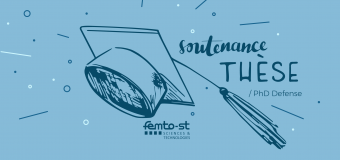You are here
- Home
- Kevin JABOVISTE : "« Experimental characterization and modeling of damping devices for the reduction of mechanical vibration..."

Kevin JABOVISTE : "« Experimental characterization and modeling of damping devices for the reduction of mechanical vibration..."
14 décembre à 10h15B Avenue des Montboucons
25030 Besançon cedex
France
PhD work : « Experimental characterization and modeling of damping devices for the reduction of mechanical vibration and the stabilization of embedded systems »
Abstract :
The work carried out during this thesis deals with the study of the dynamic mechanical behavior of passive damping solutions used for the reduction of vibration levels and the stabilization of embedded optronic systems within Thales LAS France company. These solutions integrate elastomer materials with high dissipative power, whose behavior must be perfectly controlled for a good mechanical dimensioning of vibration isolation, despite their dependence on temperature and frequency. The general objective is to improve the knowledge of these material behavior, the characterization techniques, and the method taking into account this behavior in the numerical simulations in order to improve the practices used in the engineering department that design the structures hosting these systems.
In this context, the work presented first focuses on the characterization, the modeling and the identification of the viscoelastic behavior of elastomers used in Thales LAS France damping devices. A Generalized Maxwell Model (GMM) is used to describe this behavior, and is
introduced into a finite element model of the damper to obtain a satisfactory physical representation of its dynamic mechanical behavior. The problem is rewritten as an original state space representation that is associated with a model reduction strategy to reduce computation
times. Various simulations are moreover performed to illustrate the potential of the proposed approach, such as complex modal analysis, frequency response and temporal response. Since temperature has a major influence on the mechanical behavior of elastomers, a specific
thermomechanical material model is proposed by identifying the temperature evolution of GMM parameters, and a robustness analysis on the dissipation ability of the damper in the presence of a lack-of-knowledge on this variable is carried out based on the Info-Gap theory. Experimental test results showed the appearance of a softening of the structure under heavy load, suggesting the presence of non-linearities. Another aspect of this thesis deals with the characterization, the modeling and the identification of non-linear phenomena that can
impact the dynamic behavior of the damper. Two sources have been highlighted: a material non-linearity related to the dependence of the mechanical characteristics of the elastomers to the rate of deformation (Payne effect), and a contact non-linearity related to the presence
of mechanical stops. These behaviors were implemented in a reduced representation of the damper to explain the nonlinear phenomena observed experimentally during the damping device qualification campaigns. Finally, the last part of this thesis deals with the design of a network of tuned mass absorbers (MTMD) in order to reduce the vibratory level of a structural part supporting optical systems. After a formulation of the finite element problem, a procedure for optimizing the
parameters of the MTMD is implemented and a robustness analysis of the optimal solution in the presence of uncertainties on the specific eigenfrequency to be controlled is performed. This study is carried out for different sets of parameters and a robust design optimization
method is proposed by combining the optimization procedure and the Info-Gap theory. Finally, a model of the studied system is realized as well as a simplified version of its associated MTMD in order to test the tuning rules resulting from numerical studies thanks to a series
of experimental tests.
Jury members :
- Anas Batou, Professeur, Laboratoire de Modélisation et Simulation Multi-Echelle, Reporter
- Guilhem Michon, Professeur, Institut Clément Ader, Reporter
- Etienne Balmes, Professeur, Arts et Métiers ParisTech – PIMM / SDTools, Reviewer
- Pierre-Olivier Mattei, Chargé de Recherche CNRS, Laboratoire de Mécanique et d’Acoustique, Reviewer
- Charles Arnould, Ingénieur Calcul Mécanique, Thales LAS France, Invited guest
- Eric Collard, Responsable Bureau d’Etudes Mécanique, Thales LAS France, Invited guest
- Nicolas Peyret, Maître de conférences, SUPMECA, PhD Supervisor
- Emeline Sadoulet-Reboul, Maître de conférences HDR, Université de Franche-Comté, PhD Co-Director
Gaël Chevallier, Professeur, Université de Bourgogne Franche-Comté, PhD Director
Location:
FEMTO-ST Direction (TEMIS), Amphithéâtre Jean-Jacques GANEPAIN, 15 B avenue des Montboucons, 25000 Besançon









